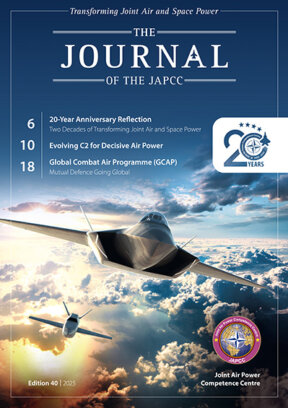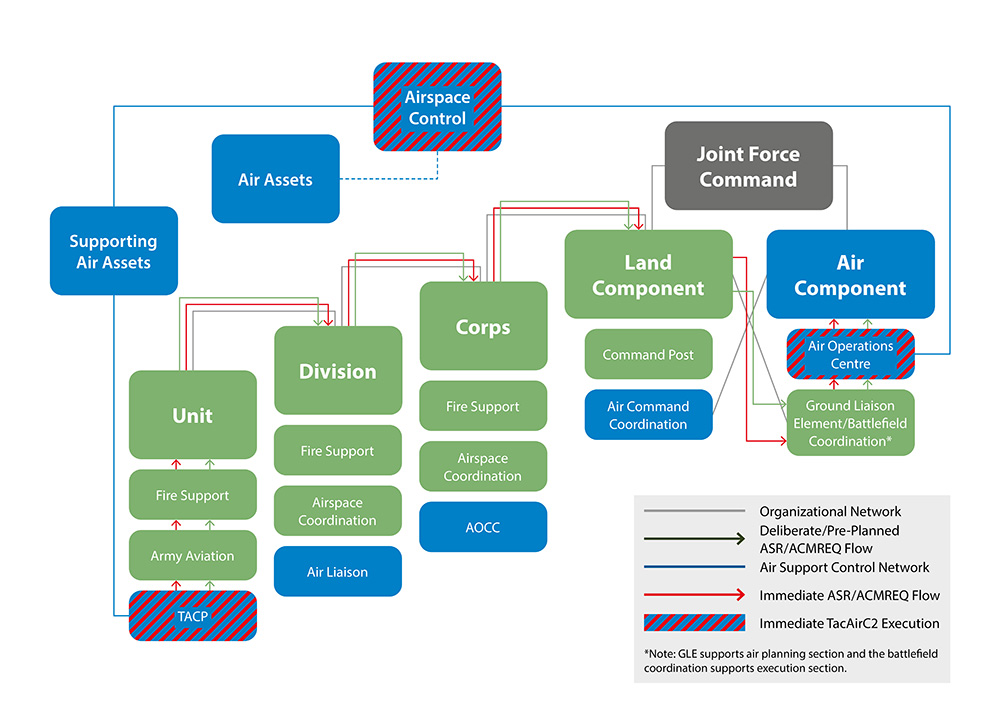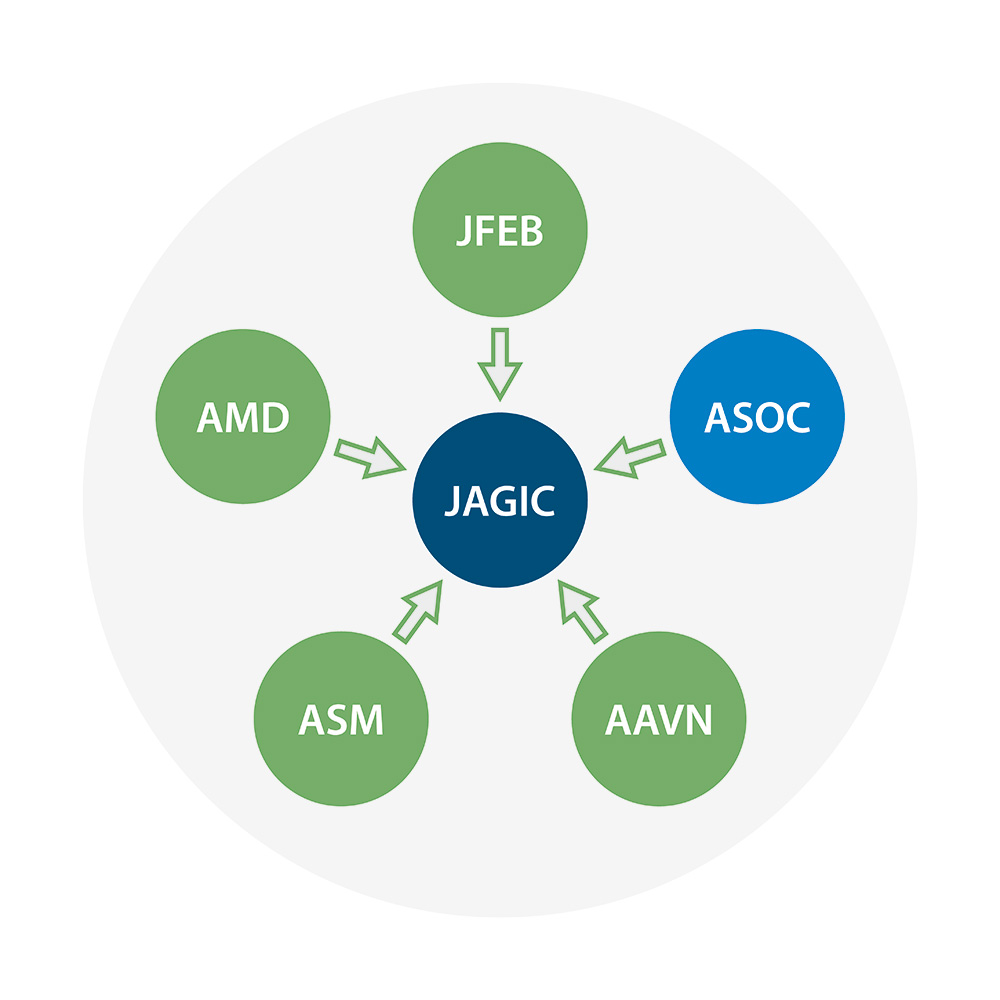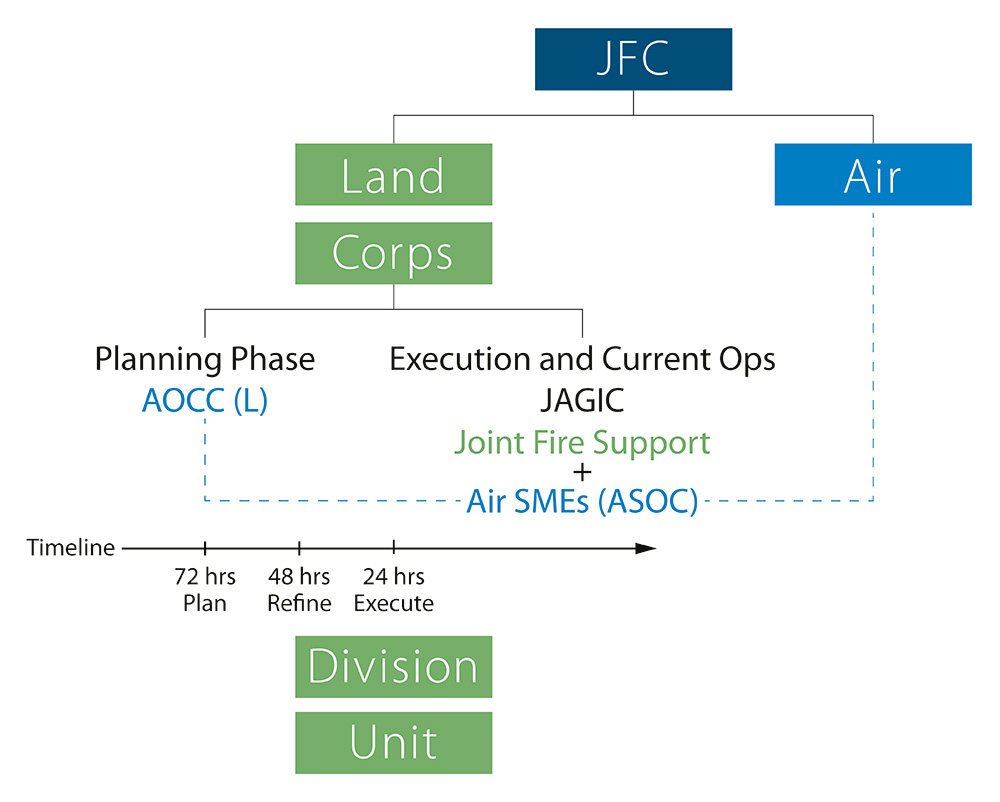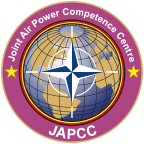Introduction
Military operations over the past century have witnessed a profound transformation, evolving from clashes dominated by single components to intricately synchronized joint and multi-domain endeavours. Within this evolution, the effective integration of air and land power – Air-Land Integration (ALI) – has become a cornerstone of operational success. Without true integration, air and land components risk desynchronization and suboptimal effectiveness, a danger highlighted by LTG Frederick Franks, Commander of United States VII Corps during Operation Desert Storm: ‘I was free to nominate targets, but the correlation between those that we nominated and those that were struck was quite poor.’1 To avoid repeating such shortfalls in a far more lethal future war, it is a strategic imperative that NATO creates and maintains a leading edge in ALI.
Historically, NATO developed a robust doctrine for air power contribution to counter-land operations (APCLO) in the ‘former’ Air-Land Battle concept. This doctrine encompassed a range of missions designed to leverage air power’s speed, reach, and precision in support of land forces and degrade an adversary’s ability to bring their land forces to bear. However, the operational landscape of the past two decades was dominated by Counterinsurgency (COIN) campaigns fought under conditions of assured friendly air superiority. For a generation of warfighters, these permissive conditions effectively reduced the broad concept of APCLO to its most frequent application: Close Air Support (CAS). While vital, this focus on CAS – engaging enemy forces near friendly troops – caused other APCLO concepts in the deeper tactical fight to atrophy.
Now, the threat of peer or near-peer adversaries equipped with advanced anti-access/area denial (A2/AD) systems capable of credibly contesting the air domain demands a fundamental shift in thinking. Future success hinges on the harmonious integration across the breadth of APCLO missions, complemented by a newly proposed land mission-set: Land Power Contribution to Counter-A2/AD (LPCA).
This article examines how NATO can ensure land commanders can leverage the full potential of air power, while air forces can harness land component capabilities – particularly long-range precision fires – to enable air operations in the modern battlefield. NATO’s initial efforts to develop ALI is centred on three emerging concepts: the Joint Air Ground Integration Centre (JAGIC), the Air Support Operations Centre (ASOC), and the ASOC Battlespace Management Area (ABMA). Together, they provide the structural foundation to advance ALI and expand NATO’s competency in Multi-Domain Operations (MDO).
Evolving Operational Realities: From Permissive CAS to Contested ALI
During the COIN era, land forces benefited immensely from reliable CAS, and the air forces grew accustomed to delivering CAS in a low-risk environment. CAS was performed at generally low altitudes, where NATO militaries leveraged the psychological impact of visible air presence and its associated effects on morale for both friendly and enemy forces.
This period fostered significant advancements in CAS capabilities. NATO initiated the certification and qualification of Joint Terminal Attack Controllers (JTACs) through the NATO standardization process, ensuring a high degree of interoperability and competence in coordinating air strikes. Technological strides, such as the Digitally Aided Close Air Support (DACAS) system, improved the accuracy and responsiveness of CAS missions, while the proliferation of Unmanned Aircraft Systems (UAS) provided persistent surveillance and dynamic targeting capabilities. These developments matured NATO’s CAS capabilities, proving highly effective within the specific context of permissive COIN environments.
However, these successes become liabilities if applied to future Large Scale Combat Operations (LSCO) against sophisticated adversaries, where the assumption of air supremacy evaporates. Peer adversaries will actively contest the air domain with integrated air defence systems (IADS), electronic warfare (EW), and fighter aircraft, increasing the risk to NATO aircraft. Furthermore, the scale of LSCO will likely generate simultaneous troops-in-contact (TIC) events across vast areas, creating a demand for air power that may exceed availability in a contested environment.
Figure 1: NATO’s Current Airspace Control Structure and Airspace Request Network.2 A 2022 analysis suggests an integration gap exists at the corps level. © NATO
Navigating this new reality requires a paradigm shift in risk acceptance and a move beyond treating ALI as a euphemism for ‘air support.’ Instead, ALI is about systematically integrating APCLO and LPCA principles based on the appreciation of the mutual benefit each domain can offer the other. For example, relying solely on air power to suppress A2/AD threats while also providing APCLO is likely untenable, especially in the opening phases of a conflict. Instead, land-based long-range precision fires, such as the existing Army Tactical Missile System (ATACMS) and the forthcoming Precision Strike Missile (PRSM), alongside other land effects (e.g. EW, intelligence, surveillance, reconnaissance (ISR), and cyber), must be integrated into the counter-A2/AD fight. LPCA must proactively shape the environment to enable air operations, reducing the burden on air assets and creating windows of opportunity for APCLO missions where they are most needed.
Bridging the Gaps: Recent NATO Efforts to Revitalize ALI
Recognizing the urgency, Allied Land Command (LANDCOM) and Allied Air Command (AIRCOM) have intensified efforts to revitalize ALI. A key catalyst was the 2020 Joint Analysis and Lessons Learned Centre (JALLC) report on ALI, which concluded that NATO’s existing Tactical Air Command and Control (TacAirC2) architecture was potentially unsuitable for LSCO and recommended extending its execution capabilities to the warfighting corps (WFC).
Acting on these findings, NATO established the Battlefield Coordination Detachment (BCD) at AIRCOM in 2022 to enhance daily liaison. In 2024, the NATO ALI Forum was created to synchronize efforts in support of the MDO concept, resulting in the ‘Making NATO ALI Ready 2024–2026’ plan. This roadmap outlines five key lines of effort (LOEs): command and control (C2), Counter-A2/AD (linking APCLO and LPCA), APCLO, airspace management (ASM), and integrated air and missile defence (IAMD). The formal ratification of the ALI Forum Charter by the Deputy Commanders of both AIRCOM and LANDCOM underscored the high-level commitment to this key effort.
Developing Core Concepts for ALI: JAGIC, ASOC, and ABMA
The JAGIC, ASOC, and ABMA concepts are central to developing NATO’s future ALI framework. Though still under refinement, they represent a significant evolution in synchronizing air and land power.
Figure 2: Typical JAGIC Execution Cell Composition, as discussed below.3 © NATO
1. JAGIC Concept
The JAGIC was developed based on lessons learned from Operation Anaconda and other missions in Afghanistan and Iraq. The JAGIC is a method of organizing personnel and equipment at the highest tactical echelon, in NATO typically the WFC, to foster teamwork between components. Its core membership includes representatives from the ASOC (air execution), surface fires, ASM, air and missile defence (AMD), and Army aviation (AAVN). This co-location and integration enable the rapid coordination, synchronization, and execution of joint fires. The JAGIC’s effectiveness hinges on this fusion, providing the Corps commander with a scalable, joint team enabling rapid decision making while minimizing fratricide risk. Since 2021, LANDCOM and AIRCOM have collaborated on developing and testing the JAGIC concept within NATO exercises, refining its structure and procedures, and advancing the concept with each exercise.
2. ASOC Concept
The ASOC is the Air Component’s team of experts embedded in the JAGIC, tasked with controlling air operations within an assigned airspace. It serves as the primary decentralized execution element for air power supporting the WFC, embodying the tenet that tactical decisions are best made by those closest to the fight. Unlike an Air Operations Coordination Centre (AOCC), which plans future operations, the ASOC’s primary mission is the real-time execution of air missions, managing immediate air requests, and providing fused air/ground situational awareness.
The ASOC’s key tasks include: exercising tactical control of assigned aircraft operating within the ABMA, coordinating with adjacent TacAirC2 agencies and airspace users, managing the Joint Air Request Net (JARN) for immediate CAS requests, providing fused air/ground situational awareness via voice communications and tactical data links (TDLs), integrating joint suppression of enemy air defences (J-SEAD) effects, and processing immediate air support requests (ASRs). Within NATO, the Deployable Air Command and Control Centre (DACCC) holds the responsibility for developing and implementing the NATO ASOC capability.
Figure 3: ASOC Command Relationships.4 © NATO
3. ABMA Concept
The ABMA is a proposed volume of airspace assigned to the WFC, with control authority delegated from the Airspace Control Authority (ACA) to the ASOC. Within an ABMA, the ASOC manages assigned air assets and deconflicts all airspace users, including friendly aircraft, UAS, and ordnance (artillery, missiles), enabling the WFC commander to rapidly execute organic fires and aviation operations without requiring further coordination with the ACA for each specific mission.
The ABMA dimensions are flexible. However, they will generally be defined laterally by the boundaries of the WFC, longitudinally from the WFC rear area to the fires support coordination line (FSCL), and vertically from the ground up to the maximum ordinate (MAXORD) of the preponderance of cannon artillery. The ABMA’s ceiling is referred to as the coordinating altitude (CA) to maintain maximum interoperability. The ABMA’s dimensions are defined and implemented in the Air Component’s Air Tasking Order/Airspace Control Order (ATO/ACO). The ABMA is flexible, and its dimensions can be dynamically adjusted in real time via coordination with the ACA based on the tactical situation, ASOC capabilities, and overall air picture.
By delegating control to the ASOC, the ABMA differs from a high density airspace control zone (HIDACZ), where control is retained by the ACA, and promises to drastically reduce the time needed to clear airspace for dynamic joint fires.
Integration in Action
These three concepts are designed to work in concert. The JAGIC provides the integrated C2 hub within the Corps HQ. The ASOC, nested within the JAGIC, provides the specialized air C2 execution capability. The ABMA provides the defined airspace within which the ASOC can exercise its delegated authority. This setup promises to achieve rapid synchronization and deconfliction of air and surface effects reducing the time needed to clear airspace for dynamic joint fires.
Figure 4: Depiction of the ABMA Concept: a volume of airspace typically aligned with the Warfighting Corps’ lateral and vertical boundaries (CL to CA). Control authority within the ABMA is delegated from the Airspace Control Authority (ACA) to the ASOC located within the Corps’ JAGIC.
Concept of Figure: © Copyrighted; Quadcopters: © Adobe; Sky and Ground Texture: © Adobe; F-35: © shangus930 – sketchfab.com, CC Attribution); Bayraktar TB2: © 3d_molier International/TurboSquid; Black Hawk: © Yi Tsung Lee – sketchfab.com, CC Attribution; HIMARS: © 42manako – sketchfab.com, CC Attribution; Mortar: © firdz3d/TurboSquid; Cannon: © Daniel Millones/TurboSquid
ALI: Preparing an MDO-Capable Force in the Context of A2/AD
Effective ALI, realized through concepts like JAGIC, ASOC, and ABMA, is a critical enabler for NATO’s broader ambition of achieving an MDO-capable force structure. MDO requires the seamless integration of capabilities beyond air and land, including maritime, space, cyber to create converging effects that overwhelm an adversary.
In the context of Counter-A2/AD, this ALI paradigm shift is vital. By integrating LPCA through the JAGIC, land forces can degrade enemy IADS, creating localized windows of air superiority or parity that allow APCLO missions to be conducted with acceptable risk. This demands a sophisticated understanding of cross-domain cueing: for example, land-based EW detecting a radar, space capabilities providing an accurate location, followed by a prompt artillery strike coordinated through the JAGIC, enabling follow-on air strikes or reconnaissance managed by the ASOC.
This integrated approach necessitates a dynamic balancing act throughout a campaign. The opening stages might heavily emphasize LPCA to degrade A2/AD systems and establish conditions for air power, potentially meaning fewer APCLO sorties directly supporting ground manoeuvre. Staffs must accept this potentially asymmetric initial contribution, understanding that land assets targeting key A2/AD nodes directly enable future air support. As the A2/AD threat is suppressed and a more favourable air situation is achieved, the balance will shift, enabling a greater weight of effort towards APCLO missions to support the land scheme of manoeuvre.
Recommendations for the Way Forward
Achieving comprehensive ALI requires sustained institutional change. While progress is being made, significant work remains. The following recommendations are crucial for advancing this topic within NATO:
Define and Codify: Formally agree on a NATO definition for ALI that reflects its modern, integrated, multi-domain context. The following is offered as a starting point for discussion: ALI is the application of Air and Land Component capabilities, coordinated and synchronized across domains, to achieve complementary and reinforcing effects that enable Joint Force objectives. This definition could stimulate conversation to support further development and direction of ALI and increase our lethality in the tactical deep fight. As Lieutenant General Sean Bernabe, Deputy Commander of United States Army Europe and Africa, has noted, ‘If we only used organic [land] options, it limits our ability to fight. Mass can be delivered by apportioned joint effects.’5
Update Supporting Doctrine and TTPs: Update AJP-3.3.2 Close Air Support and Air Interdiction to broaden its scope and fully incorporate the spectrum of APCLO missions within the new ALI framework. Amend AJP-3.3.5 Airspace Control to include the ABMA concept, associated procedures, and delegation parameters. Update relevant ATPs (e.g., ATP-3.3.2.1, ATP-3.3.5.1) to provide the detailed ‘how-to’ guidance aligned with the updated AJPs.
Continue Experimentation and Refinement: Leverage NATO exercises, wargames, and experimentation venues to rigorously test and refine the JAGIC, ASOC, and ABMA concepts. Establish robust feedback mechanisms to capture lessons learned and rapidly iterate on doctrine, TTPs, and organizational structures. Ensure Component Commands and subordinate Corps HQs actively participate and develop proficiency.
Ensure Interoperability: Conduct comprehensive capability studies to identify requirements and ensure the necessary C2 systems, communication networks, TDLs, and situational awareness tools used within the JAGIC and by the ASOC are interoperable with existing and future NATO standards. Prioritize solutions that enable seamless digital information exchange between air and land platforms and command nodes.
Institutionalize Training and Certification: Once JAGIC, ASOC, and ABMA are formally institutionalized in NATO doctrine, develop standard training and certification requirements to ensure the force is ready to execute.
Foster a Joint Culture: Promote education, cross-component assignments, and integrated training opportunities to break down cultural barriers and foster the mutual trust and understanding for effective ALI.
Conclusion
The integration of NATO’s air and land capabilities – the ‘blue’ and ‘green’ domains – is a strategic necessity for maintaining credible deterrence in an era of renewed great power competition. Victory against peer adversaries requires a shift away from component-centric operations and legacy models optimized for permissive environments. NATO must embrace a comprehensive, effects-based approach to ALI, moving beyond the recent focus on CAS.
The development and refinement of the JAGIC, ASOC, and ABMA concepts offer a pathway to synchronize APCLO and LPCA, enabling commanders to generate integrated joint effects at the speed and scale required by LSCO within an MDO framework. While recent initiatives by AIRCOM, LANDCOM, and the wider NATO community have generated positive momentum, significant work remains. Fully realizing the potential of modern ALI requires sustained commitment from strategic leaders and a truly integrated joint mindset down to the tactical level.

